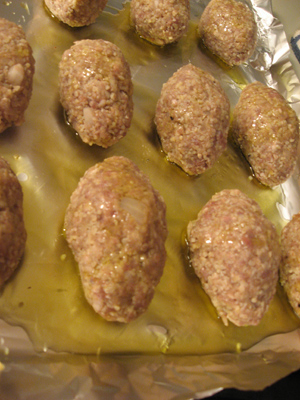Kibbeh is one of the stalwarts of Levantine cooking, and comes in as many versions as there are towns or people who make it.
Loosely, kibbeh refers to a mix of burghul (bulgur), ground lamb, and spices. It can be served raw (kibbeh nayye), spread flat and baked (kibbeh bis-sayniyyeh), or formed into small ovals and fried (kibbeh mekliyeh). Both the baked and fried varieties consist of two components: the bulgur and meat mixture, which forms an outer shell, and an inner layer of stuffing, comprised of more ground meat, fried onions, and various flavourings.
What on earth, you may be wondering, might a recipe calling for this much meat be doing here? Well, it’s actually less than you’d think, for starters – 300 grams for 4 people. And while we’re big advocates of cutting back on resource-intensive meat consumption, we’re not convinced that it needs to be cut out entirely.
Echoing the sentiments of the fabulous Mark Bittman, who we were recently lucky enough to hear in person, “It would be better if our animal consumption went down to 10%, but that last 10% doesn’t make much difference.” Once in a while a bit of meat is just fine, and there are few better ways to indulge than this.
As with all the classic recipes we’ve been featuring lately, this one is meant as an introduction – a starting point to serve as the basis for experimentation. Play around with spice combinations, add in a bit of pomegranate molasses, or toss in some chopped herbs if you’re so inclined.
We’re going in for the most familiar version of kibbeh – the stuffed, oval-shaped meatballs most often found on restaurant menus. Our one major change is to broil the kibbeh rather than deep-fry it. It won’t be quite the same, admittedly, as the more decadent original, but deep-frying involves more waste than we’re really comfortable with. If you crank your oven up high enough, and rub the kibbeh with a bit of oil, you’ll still get the essential crispy crust.
Kibbeh Mekliyeh
 For the kibbeh (outer shell):
For the kibbeh (outer shell):
- 1/2 cup fine bulgur
- 225 grams ground lamb
- 1 1/2 medium onions, coarsely chopped
- 1 tsp salt
- 1/2 tsp ground allspice
- 1/2 tsp cumin
- pinch of cinnamon
- pinch of cayenne pepper
- 2 tbsp olive oil
For the filling:
- 1 tsp olive oil
- 2 tbsp pine nuts
- half an onion, minced
- 75 grams ground lamb
- 1 tsp sumac
- 1/2 tsp ground allspice
- pinch of cumin
- pinch of cinnamon
- salt and pepper to taste
-
- First off, prepare the bulgur: rinse it in several changes of water, then leave to soak in fresh water for 20 minutes.
- Meanwhile, make the filling: Put a small frying pan over medium heat to warm, then toast the pine nuts in the dry pan until golden and fragrant. Transfer pine nuts to a small mixing bowl, return pan to the stove and heat the olive oil. Gently sauté the onion until softened, then add the lamb and continue sautéing until the meat is just cooked through. Pour the meat and onions into the bowl with the pine nuts, then add in the remaining ingredients and stir to blend. Taste, adjust seasonings as necessary, and set aside.
- Drain the bulgur through a fine mesh sieve, then get out as much excess water as you can by pressing down on it or by squeezing it in handfuls.
- To make the outer shell, pulse the onions in a food processor (this is essential to the texture – it’s nigh impossible to get it right by hand) until finely chopped. Add in the spices and pulse again to distribute. Pour the onions into a large mixing bowl, then add in the bulgur and ground lamb. Knead by hand until the mixture comes together and all the ingredients are evenly distributed. Refrigerate for about 20 minutes to let the mixture chill through.
- Preheat your broiler to 200°C, and generously oil a cookie sheet.
- To form the kibbeh, take a handful of the outer shell and press between your hands to get it to cohere, turning it over a few times to make an oval shape. (It’s a bit like packing a snowball, if that’s an experience you’ve ever had.) Gently press your index finger in to create a pocket for the filling, and then spoon in a small amount of the fried stuffing. Pinch the top closed to seal, and turn a couple more times in your hand to ensure the kibbeh will hold together. Lay on the greased cookie sheet.

Once all the kibbeh are formed, drizzle them with the olive oil and turn gently to coat. Broil until crisp and browned on top, about 8 minutes, then turn and broil another 6 minutes or so.
To serve, drizzle kibbeh with either a yogurt dipping sauce (stir a pinch of salt and some finely chopped cilantro, parsley or mint into plain yogurt) or a tehini dipping sauce (mix some lemon juice, salt, and a clove of minced garlic into a bowl of well-stirred tehini.





Did you knead it enough, refrigerate the dough, and make sure your oil was hot enough when frying? These could also be factors that led to the break down of your kibbeh…
I made this and when I went to turn them, they nearly all fell apart. Is there a missing ingredient here? Perhaps eggs?
I love kibbeh when cooked in sour soup. So yummy for the winter time.